What is the strongest magnet you can buy? We found out!
When thinking of magnets, we often think of small metal objects. In the world of man-made super magnets, this could not be further from the reality. The current strongest magnet in the world took over two and a half years to build, and over $3.5 million.
What is the strongest magnet? The strongest magnet in the world is currently a man made pulse magnet, which is a type of electromagnet, at the University of Tokyo. Researchers were able to produce a magnetic field that reached 1,200 teslas.
In order to really appreciate how unbelievable 1,200 teslas is, the Earth’s natural magnetic field is one twenty thousandth of tesla! The strongest medical imaging machine that we have created is 400 times weaker than this pulse.
The explosion that followed the magnetic pulse bent the metal housing that the device was in, and blasted the doors open. If the topic of strong magnets is something that interests you, all of the information that you are looking for is contained throughout the sections of this article.
What is the strongest magnet?
Magnets are used in multiple aspects of our everyday lives, from the small task of placing a photograph on the refrigerator to flying an aircraft in outer space.
With that being said, there are certainly different levels of strength that are assigned to each individual type of magnet, of which there are many. Before we can get into the topic of what the strongest magnet is, we will need touch on the main points of what each type of magnet consists of.
Take a look at the list down below to get a general overview, and keep reading to get all of the details.
Main types of magnets
- Permanent magnets
- Temporary magnets
- Electromagnets
Permanent magnets are almost exactly what they sound like: magnets that are permanent. In other words, they have a continuous magnetic field.
Magnetic flux density, or the magnetic B field are other phrases used to describe this persistent magnetic field.
These magnets can attract some materials from a distance almost magically due to this field which extends beyond the physical magnet itself.
The invisible magnetic field around permanent magnets is what allows them to attract certain materials. The most obvious materials that permanent magnets attract are iron and metal that contains iron like steel.
There are other materials similar to this that they can attract, which are called ferromagnetic materials. Examples of other ferromagnetic materials are cobalt, nickel, gadolinium, lodestone, and manganese.
Most ferromagnetic materials are metals. They are characterized by their unique crystalline structure, as well as their material makeup.
Materials like these can also be referred to as temporary magnets, though this descriptor is somewhat misleading.
Temporary magnets work similarly to permanent magnets, but in contract they require a strong magnetic field in order to work at all.
Often these are made from softer metals. This means that they don’t have that persistent magnetic field which is really what we usually think of when we hear the word magnet.
Temporary magnets are very useful for electromagnets within motors, as well as other similar applications. Some common examples of temporary magnets are nails, paperclips, or refrigerator doors.
So when you think of magnets attracting other objects, they aren’t only pulling them, they are temporarily giving them a magnetic charge, turning them into temporary magnets themselves.
Electromagnets are another kind of magnet. These are made by taking a metal core piece, which is often made of some mixture of iron, into a wire coil that will carry an electrical current.
When the electricity passes through this coil, it creates a very strong magnetic field. This field can be made stronger or weaker depending on how many wire coils are used, as well as how much electricity is being pushed through them.
What makes electromagnets unique, besides their electrical makeup, is that once you turn off the electricity, the field immediately disappears. So many modern items use these electromagnets, but a great example is the large disk on crane machines used within junkyards.
While electromagnets use a completely different method of creating a magnetic field, that field still works the same as a permanent magnet’s field. It can pick up the same materials by temporarily effecting their atoms and domains with their magnetic power.
Unsurprisingly, though we can make extremely strong magnets out of rare earth metals, the most powerful magnets are man made with an electromagnet. While we can make strong consistent magnets, the strongest magnetic field we can create is a pulse magnet.
These magnets put out a very temporary magnetic pulse, which lasts a fraction of a second.
The senior author of the study done in the University of Tokyo, Shojiro Takeyama, has been trying to surpass 1,000 teslas for 20 years. In pulse magnets like this, a series of coils with inner copper coils are created.
An intense 3.2 megajoules of power is run through them, upon which the inner copper coils collapse at a rate of over 3 miles per second.
When this happens, the magnetic field within these coils compresses as it reaches intense high levels, and eventually it collapses entirely resulting in a large explosion.
Humans have been able to make larger magnetic fields, however none have been able to be conducted indoors.
Both Russian and American researchers have done outdoor tests that use explosives and magnetic coils, and these have allegedly produced fields up to 2,800 teslas.
The biggest problem is that due to their outdoor environment, taking precise measurements and conducting tests is extremely difficult.
While this powerful pulse is impressive, we also have significant electromagnets that can continuously pump out very high tesla counts. The Project 11, the world’s most powerful resistance magnet, can reach up to 41.4 teslas.
The name “Project 11” was a reference to the mockumentary “This is Spinal Tap” and the phrase “turn it up to 11.” Project 11 resides within the National High Magnetic Field Laboratory, and surpasses the last most powerful resistance magnet by an impressive eight percent.
The engineers at the National High Magnetic Field Lab were able to push this magnet due to a variety of factors, one however being the 32 megawatts of direct current (DC) power.
The engineers, who has experience designing the lab’s other strong magnets, were able to create significant improvements to maximize the electrical current going through the coil.
The larger magnet also allowed them to use quite a bit more coils, which let the electricity be better distributed.
Usually, these resistive magnets are used for research. These magnets are used to help us better figure out materials that are best suited for quantum science, such as quantum computers.
While this seems like a very futuristic application, it also is used to test things like Alzheimer’s drugs and their effects on the brain, or to look at the molecular makeup of materials.
So, back to the point of the strongest magnet. We have already established that electromagnets are the strongest that we can make.
To continue on, take a look at the quick list down below, which will give you an idea of which other types of magnets come in close second to the mighty electromagnet.
The strongest general magnet types (in order):
- Electromagnet
- Permanent magnet (Neodymium)
- Temporary magnets
Permanent magnets, or more specifically, Neodymium magnets, come in a close second to the number one strongest electromagnet.
These types of magnets are made up of rare earth materials, which are some of the strongest substances that can be found in the world.
When Neodymium magnets are produced, a mixture, or alloy, of these chemical elements are crushed up into a fine powder, and then carefully compacted and shaped in to the magnet.
While discussing the topic of the strongest magnets, Neodymium is definitely a top contender. Although not necessarily as strong, the rest of the permanent magnets follow directly behind it on this list.
Finally, temporary magnets have the least amount of strength out of all magnet types. This is due to the fact that they do not have any magnetic field or force of their own. Instead, they depend solely on the magnetic force from a stronger magnet that is nearby.
In the absence of this supporting force, temporary magnets are not magnetic at all.
While the same thing can technically be brought up about electromagnets, since they are considered to be temporary as well, they are still much stronger in comparison.
With the electronic wiring inside of electromagnets, as well as the ability to make alterations for strength and power, it still comes out as number one for the strongest magnet that you can find.
Related products - What is the strongest magnet you can buy? We found out!
-
Pot magnets with hook, Ø20 mm.
MAGZ-303-P

Strength 13.0 kg. 5,92 7,40 EUR
In stock -
Power magnet, Block 10x10x4 mm.
MAGZ-190-P
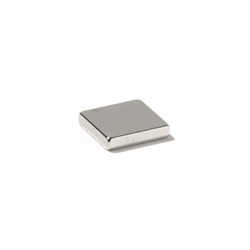
Strength 2.2 kg. 2,28 2,85 EUR
In stock -
Power magnet, Block 20x20x5 mm.
MAGZ-105-P
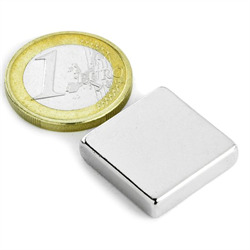
Strength 6.0 kg. 5,08 6,35 EUR
In stock -
Power magnet, Block 60x30x15 mm.
MAGZ-141-P
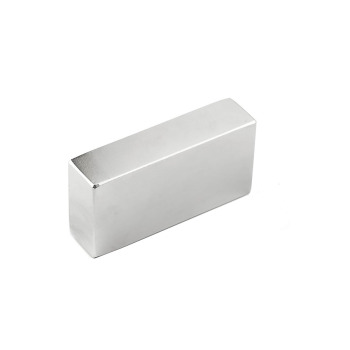
Strength 56.0 kg. 26,32 32,90 EUR
In stock -
Power magnet, Dics 60x5 mm.
MAGZ-413-P
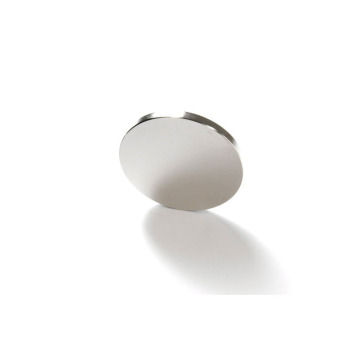
Strength 22.0 kg. 20,00 25,00 EUR
In stock -
Power magnet, Dics 30x15 mm.
MAGZ-401-P
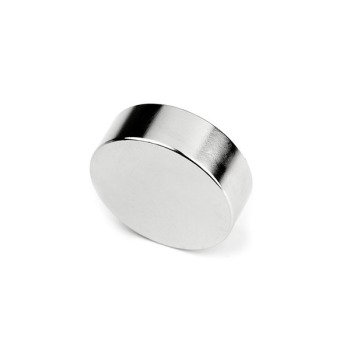
Strength 23.0 kg. 13,12 16,40 EUR
Out of stock -
Power magnet, Block 30x30x15 mm.
MAGZ-148-P
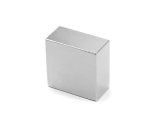
Strength 35.0 kg. 22,24 27,80 EUR
In stock -
Pot magnet with hook, Ø32 mm.
MAGZ-1307-P
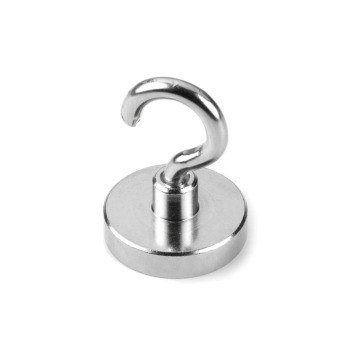
Strength 30.0 kg. 9,56 11,95 EUR
In stock
How do magnets use their strength?
Before beginning the discussion of how magnets use their strength, we will look at how magnetic fields are first created.
The very basis of magnetic fields is that they are what an electrical field changes into when something that has an electrical charge starts to move around. This is a complex concept, but there are easy ways to break it down.
Though we cannot see it with our bare eye, magnetic material is made up of atoms which have electrons that spin around them. You can think of these as microscopic particles that all have an electric charge, and are basically very small magnets.
The atoms that make up things like iron and steel are arranged into very small groups called domains. These domains hold billions and billions of atoms, and each of these domains are the extremely small magnets we preciously talked about.
Normally, these domains are scattered about and point in many different directions. When magnetic material is put within a very strong magnetic field, the domains will start pointing to the direction of the magnetic field.
Once more than half of the domains start pointing, the magnetic material is classified as a magnet.
Every magnetic field has something called the magnetic moment. There is a plethora of very in depth physics that can go into explaining what this is, however we will simplify it to it’s base definition: A magnetic moment is a vector that defines the magnet’s general magnetic properties.
To visualize, think of a rectangular bar magnet. These magnets have a positive pole and negative pole, also known as a north pole and south pole. While looking at the bar, each pole will be on its own respective side.
The magnetic moment of this magnet is going to point for the south pole of the bar magnet to the north pole.
Moving on, there is a specific process that each type of magnet goes through in order to attract other objects. This will obviously vary between permanent, temporary, and electromagnets, which is what we will start out with in the table down below.
|
Type of Magnet: |
Magnetic Field: |
How It Attracts Other Objects: |
|
Permanent Magnet |
Has its own magnetic force |
Manipulates electrons of object in question to attract it |
|
Temporary Magnet |
Gains magnetic force from a stronger (permanent) magnet |
Manipulates electrons of object in question to attract it |
|
Electromagnet |
Gains magnetic force from electric current (also a type of temporary magnet) |
Tiny particles from magnetic field manipulate electrons of object in question to attract it |
As you can see, the process of attracting objects varies between the different types of magnets. Permanent and temporary magnets follow a very similar process, though, due to the fact that temporary magnets use the force of a stronger permanent magnet in order to carry out the same tasks.
Both of these magnet types will us the electrons of the object in question in order to pull it forward and attract it. This is done through the magnetic force that is created around the magnet itself.
While electromagnets go through a process that is not too far off from this, they have different means of gaining their magnetic force. This is achieved when an electric current flows through the coiled wires inside of the magnet.
As a result, the tiny particles from the magnetic field manipulate the electrons of the object in question in order to attract it, just like the other types of magnets.
This discussion of how each magnet attracts other objects brings us to the last point we will touch on in this article: how magnets react to each other.
After learning all about how permanent, temporary, and electromagnets gain and use their power in order to pull objects toward them, you might be curious to find out what would happen if you placed them next to each other.
The first thing to consider when thinking about magnets attracting each other is something called polarity.
Polarity is basically defined as the two sides of a magnet, which are called the North and South pole. As you can probably guess, these two poles are located on each respective side.
When it comes to magnets attracting each other, the saying goes that opposites attract. In other words, when the North Pole of one magnet is next to the South Pole of another, they will stick together, which is also known as being attracted.
On the other hand, when the North Pole of the same magnet is placed next to the North Pole of the other magnet, they will actually repel each other.
This means that the two magnets will not be able to stick together, but instead they will push away from each other.
When you are dealing with the polarity of magnets, there are a few ways to be able to find out what you are dealing with, or otherwise identify the poles.
This can be done by conducting a series of small tests, which can be completed with the items that you have in your own home, or you can simply use another magnet to get the job done.
There are several reasons why you might need to know the polarity of your magnet, whether you are completing a craft project or you are interested in the topic and just want to go through with a simple science experiment.
Either way, you can use a compass to have your North and South Poles pointed out to you by the needle, or you can just put two magnets together and test them out until you have located the opposite or attracting poles that you needed.
There are plenty more tests that you can try in order to find the polarity of your magnet, all of which can be found through a simple Google search.
As you can see, magnets are some of the strongest objects in the world. Although you might underestimate their strength due to your experience with tiny refrigerator magnets, they are definitely a force to be reckoned with.
To sum it all up, electromagnets are the strongest magnets, due to the fact that they can be engineered and manipulated to deliver these results. However, the neodymium magnet on the front of your refrigerator surely comes in a close second when they are up for a comparison.